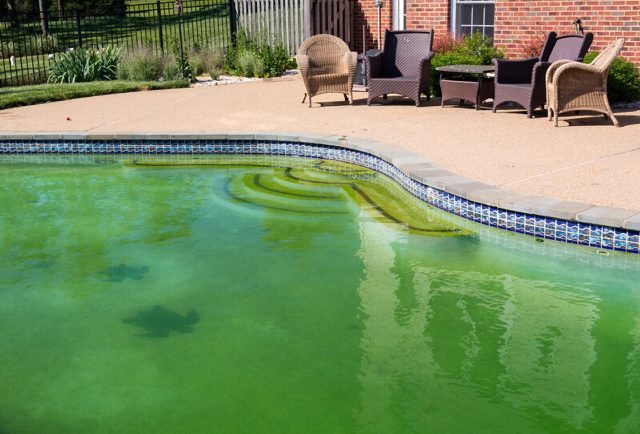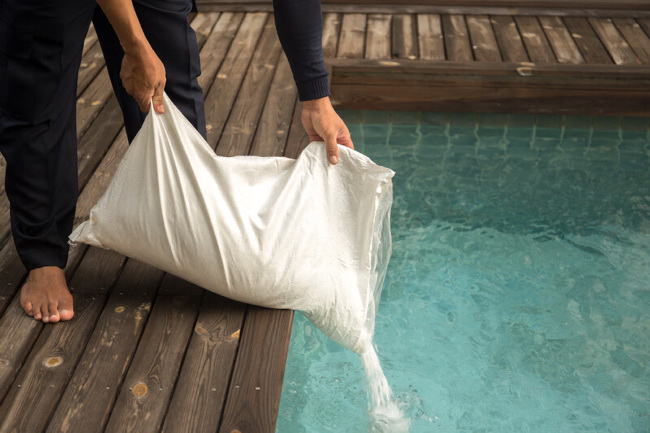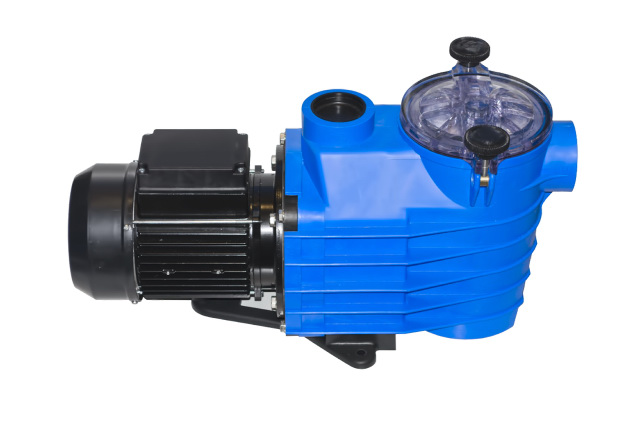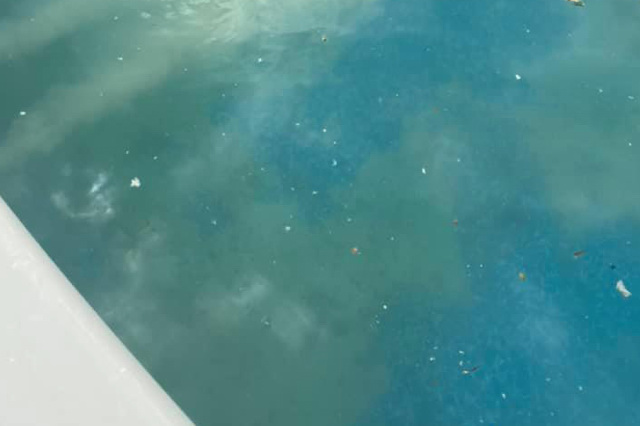A green pool, one that has algae in it, is a troublesome and often expensive problem to encounter due to chemical treatments and labor. But what if you could get rid of algae naturally from your pool?

Can you use everyday household detergents or cleaners to treat algae? Will these natural treatments take care of any variation of algae? That’s what we’re looking at today.
Article Contents
Natural Methods to Remove Algae from Your Pool
There are a few methods you can use to treat algae in your pool without the use of strong chemicals. The benefit of using natural algae treatments is that it’s safer for you. Less harsh on the pool’s chemistry, and they are cheaper in cost.
Natural remedies for cleaning algae out of a pool are generally preventative, but with a little elbow grease and a homemade detergent mix, you can remove algae from your pool naturally. Whilst these remedies are handy for removing mild algae issues, but not for severe algae. More on this below.
1. UV lights
An interesting and natural way to prevent algae, or remove minor algae growth, is using UV lights. UV lights work by hooking up to your return line and being plugged into an electrical outlet. When the pool water passes over the UV light, the light destroys the DNA of algae and bacteria and prevents mold from growing.
Light feeds algae through photosynthesis. When single-celled algae are exposed to UV light, the high levels of ultraviolet rays kill the algae. This is an economical way to maintain the health of your pool, but it’s not guaranteed to eliminate all algae and bacteria. It will only kill algae that are floating in the water and not algae that may be on the walls and floor of your pool.
And for a heavy algae outbreak, you still need to treat your pool with chemicals to completely eliminate the algae and prevent a second outbreak.
What kind of algae do UV lights kill?
- Green
How to use UV lights for algae
- Cut the PVC pipe that runs from the pool filter to the pool
- Install the quartz glass sleeve in line just behind the filter
- Once it’s turned on, the pool water will circulate through the plumbing, and the UV lights will kill the single-celled algae
2. Salt (Super Chlorinate with Saltwater Generator)

Whilst just adding salt to your pool will not get clean a green pool. But if you already have a saltwater chlorine generator, then you may be able to use it to get rid of algae. Naturally, that is, without other chemicals.
You probably already know salt chlorinators produce chlorine by changing the chemical makeup of salt cells, converting them to chlorine. But you might not have known that you can get help to prevent algae with the touch of a button by Super Chlorinating your pool.
Super chlorinating a swimming pool is an underutilized maintenance tool. Super chlorinating increases the free chlorine level in your pool. By increasing the free chlorine level, you kill off harmful bacteria and increase your sanitation level.
Super chlorinating should be done after a heavy bathing load, heavy rain, or to clear up a cloudy pool. If you have a saltwater pool, this is the cheapest alternative to start with because super chlorination requires no extra chemicals or tools. Just increase the power of your SWG (saltwater chlorine generator).
The disadvantage of this method is the extra wear and strain you put on the salt cell. Additionally, the salt cell may not be able actually to produce enough chlorine fast enough to kill the algae. Killing algae requires high levels of chlorine, somewhere between 10 and 30 ppm. If this is the case, you’re best to shock your pool with liquid chlorine or calcium hypochlorite.
What type of algae does super chlorinating kill?
- Green
- Black
How to use super chlorination to kill algae
- Clean your pool filter
- Check to make sure your salt level is within the recommended range
- Turn the salt system to 100% (super chlorination)
- Run the system for 24 hours
- Clean the filter
- Test the chemical levels
3. Baking Soda
- Increases alkalinity & increases plus stabilizers pH
- Works in pools & spas (compatible with bromine, chlorine & salt systems)
- Cheaper than pool store alternatives
Low pH and alkalinity levels are breeding grounds for algae to grow. Baking soda or sodium bicarbonate has a high pH of 8 and is used in swimming pools to raise the pH or alkalinity. Adding baking soda improves the stability and clarity of your pool.
If you have spots on your walls, you can manually scrub the spots with pure baking soda to remove them. The coarseness of baking soda is effective at scrubbing away algae with a pool brush. While many commercial pool chemicals include sodium bicarbonate, baking soda contains only the natural ingredient without synthetic chemicals.
If the algae still come back, you will have to use chlorine or an algaecide. Algae can be hard to eliminate, depending on what variant it is. Even if you “get rid” of algae where you can’t see it, the spores could still be alive, and only chemicals will kill the spores.
What type of algae does baking soda kill?
- Green
- Black
How to use baking soda on algae
- Skim the pool to remove visible debris
- Clean the pool filter
- Add baking soda to the pool over the spots
- Manually scrub the spots with a pool brush
- Vacuum up the dead algae that are present
- Run your system for 24 hours
- Clean the filter
- Test the chemicals
4. Borax
- Multipurpose cleaning agent
- DIY laundry soap, fabric softener & carpet freshener
- Always pure ingredients with no additives
Borax works the same way as baking soda for algae spots in your pool. Manually scrub the algae with a pool brush and borax until the algae spots are removed, and proceed to vacuum, clean the filter, balance the chemicals, and allow the system to run for 24 hours.
Borax is a safe chemical to use in your pool and helps maintain the pH level, which is critical for preventing future algae blooms. Although borax is not considered an algaecide, it has the same benefits as commercial algaecides without the other chemicals.
What kind of algae does Borax kill?
- Blue
- Green
How to use Borax for algae
- Skim the pool to remove visible debris
- Clean the pool filter
- Add Borax to the pool over the spots
- Manually scrub the spots with a pool brush
- Vacuum up the dead algae that are present
- Run your system for 24 hours
- Clean the filter
- Test the chemicals
5. White Vinegar

White vinegar is an effective cleaner often used on algae in pools and ponds. It will also clean other components in your pool and is non-toxic. White vinegar is effective because it is acidic. As such, it is also effective at removing calcium buildup on pool tiles. White vinegar is used for algae spots on the walls or bottom of your pool.
Vinegar breaks down algae because of its acidity. Although it effectively removes algae spots from a pool, it probably won’t get rid of it completely. The algae can grow back quickly, especially if it’s black algae.
What kind of algae does vinegar kill?
- Green
- Black
- Blue
How to use vinegar for algae
- Skim the pool to remove visible debris
- Clean the pool filter
- Add vinegar to the pool over the spots
- Manually scrub the spots with a pool brush
- Vacuum up the dead algae that are present
- Run your system for 24 hours
- Clean the filter
- Test the chemicals
6. Orenda Treatments
Orenda offers an educational resource for pool owners, and they also offer eco-friendly treatments for your pool. Their company mission is to provide you with the materials needed for crystal clear water clarity with as few chemicals as possible.
One of the treatments they offer to control algae is the PR-10,000 Phosphate Remover. Phosphates provide algae with their prime nutrients, so this is a great product to use for algae prevention. PR-10,000 Phosphate Remover is designed to interact with phosphates in order to remove them by hardening them on contact, therefore removing them from the pool’s solution. You can get the product here:
- Increase water clarity
- Breaks down oil and non-living organics
- Help maintain phosphate levels
There are websites that claim that Orenda treatment gets rid of algae, but according to their website, “No Orenda product will kill the algae, so you will need to shock with unstabilized chlorine and lower the pH. Drop the pH to about 7.4, and shock with liquid chlorine (sodium hypochlorite) or cal hypo (calcium hypochlorite). Algaecide is not necessary because chlorine is the best algaecide.”
Do Natural Algae Treatments Work in Pools?
Natural algae treatments only work on algae in your pool as a preventative measure or to remove algae. Natural algae treatments are not usually effective at killing algae in pools. Although minor algae issues can be treated with natural products, there’s a good chance the algae will return because the spores will still be alive.
Natural treatments of algae that don’t kill the algae will leave harmful bacteria from the algae that are not safe to swim in until they are killed. Chlorine and EPA-safe algaecides are the best ways to kill algae and prevent it from growing again. A swimming pool is safe within 24 hours of shocking it with chlorine.
Proper maintenance of your pool is the best preventative maintenance against algae growth. Weekly brushing and chemical balancing, and monthly filter cleaning is the best way to prevent algae from forming in the first place. Algae are hard to kill and once it forms, chlorine or algaecide and manually cleaning is the only way to ensure that the algae is gone.
Are There Benefits of Chemical-Free Algae Removal for Your Pool and Health?
The benefits of using chemical-free algae treatments are minute compared to the overall health of your pool and its bathers by not killing algae. While some algae, such as red tides, blue-green algae, and cyanobacteria, are harmful, green algae is not harmful to personal health, but the bacteria that feeds off of it is harmful to people.
Swimming in an over-chlorinated pool is safer than swimming in a pool with bacteria or algae. Since chlorine evaporates rather quickly, especially in the summertime, algaecides or chlorine is the best way to kill algae. After shocking your pool and treating it with an algaecide, it is safe for bathers within 24 hours.
Health Benefits
- Not harmful to people or pets
- Good to use for people with skin allergies or sensitive skin
Environmental Benefits
There’s no doubt that natural remedies for algae are better for the environment. And while pool chemicals can be harmful to the environment, there are measures you can take to eliminate the environmental footprint your chemicals could leave behind.
Running your pump responsibly, using EPA-certified chemicals, and disposing of them properly will drastically reduce, if not eliminate, the environmental risk posed by pool chemicals.
Drain Responsibly
Pool chemicals, especially while draining a pool or spa, can harm the environment. When draining a pool or spa, it must be run to a storm drain (check with your local municipality first) so that a water treatment facility can treat and eliminate harmful chemicals.
Use a Variable Speed Pump

A big part of the algae treatment process, and everyday pool maintenance, is running the pool pumps. The Department of Energy estimates that pool pumps in the US make up 0.9% of US energy consumption annually.
Pool pumps also use a lot of energy and use between 3,000-5,000 kWh per year. For this reason, single-speed pumps are no longer legally allowed to be sold in the United States, and if an existing single-speed pump has burned out, it can only be replaced by a variable-speed pump. Actions like this are enforced by the Department of Energy to cut down on energy consumption.
Are Natural Algae Removal Products Cheaper?
Natural algae remedies are cheaper than commercial algaecides and chlorine but, again, are not nearly as effective. If you have a cloudy pool or just algae spots, it may be worth trying a natural remedy first to save money.
These natural treatments only work sometimes, and during the interim treatment, the algae can possibly get worse, which will cost you more money in the long run. On average, for a 20,000-gallon pool, a chemical algae treatment will cost around $100 and clear up your pool within 48 hours.
Whichever treatment you choose, you should still clean or replace the filter after the water is clear. Small algae particles are often left inside the microfiber pleats and can leach back into your pool water through the filtration system.
Although filters are expensive, not replacing them after an algae treatment can cause you to have to treat your pool again, stacking up on the costs. It’s best to get a treatment plan from a reputable pool store and follow the instructions in the letter. It may be a little pricey, but treating an algae outbreak one time is always cheaper than treating the same issue multiple times.
Will Adding Vinegar to My Pool Kill Algae?
Vinegar is good at killing algae and is non-toxic. If I had to choose one natural treatment other than salt, I would use white vinegar. White vinegar is an amazing cleaner, and along with killing the algae, it will also clean the plumbing system and filter.
Will Baking Soda Clear Algae from a Pool?
Baking Soda can be used to spot-treat algae in your pool. It can also adjust the pH and alkalinity to the ideal levels to kill algae. However, adding baking soda to a pool alone will not kill algae. It should be used in conjunction with shocking/super chlorination and an algaecide.
If using baking soda, be careful not to use too much, as it will change the alkalinity and pH of the water.
Does Salt Get Rid of Algae from a Pool?

Adding salt to a pool will not kill or eliminate algae from a swimming pool. Algae grow in the ocean, and the salt levels in the ocean are 3-10 times that of a home swimming pool.
You may be wondering about saltwater pools. Saltwater pools contain salt but it’s not the salt that sanitizes the water. The saltwater is converted into chlorine through electrolysis by the pool’s saltwater chlorine generator. It’s the chlorine from this process that kills algae and bacteria.
If the salt level is low in your saltwater pool, it may hinder the chlorine generator’s performance.




